Gull facts for kids
Quick facts for kids Gulls |
|
|---|---|
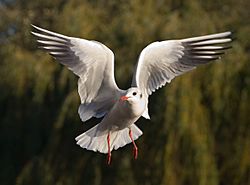 |
|
| Black-headed gull (winter plumage) | |
| Scientific classification | |
| Kingdom: | |
| Class: | |
| Order: | |
| Suborder: |
Lari
|
| Family: |
Laridae
|
| Genera | |
|
Larus |
|
Gulls, often called seagulls, are a type of bird. They belong to the bird family called Laridae. These birds are part of a larger group known as Charadriiformes.
Most gulls are white with grey or black wings. They usually have a yellow beak and are about the size of a chicken. Some types of gulls are much smaller. Gulls are very good at finding food. They eat many different things, but they especially like meat. They often look for food that people have thrown away or for dead animals. Gulls have learned to live and raise their young in places where people live. Most gulls are active during the day and sleep at night. They like to sleep on beaches or on calm water, like lakes or the sea.
Gulls used to live only near the sea. This is because they are water birds with webbed feet for swimming. But now, you can see them more often inland. This is because they can find food easily wherever people live. They often find food at garbage dumps or in the streets of towns and cities. Gulls are quite intelligent birds. They use many different sounds and body movements to communicate with each other.
Most types of gulls lay eggs once a year. They usually have two or three chicks (baby gulls). Mother gulls are very protective of their eggs and chicks. They will bravely defend them from danger.
Contents
What Gulls Look Like
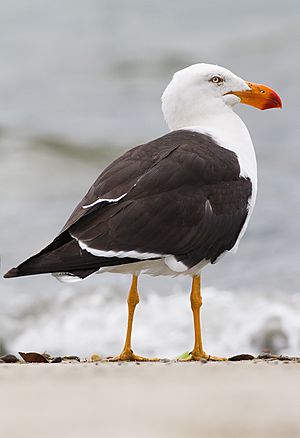
Gull species come in many different sizes. The smallest is the Little Gull, which weighs about 120 grams (4.2 ounces) and is 29 centimeters (11.5 inches) long. The largest is the Great black-backed gull, which can weigh up to 1.75 kilograms (3.8 pounds) and be 76 centimeters (30 inches) long.
Most gulls have a similar body shape. They have strong bodies, long wings, and necks that are not too short or too long. Their tails are usually rounded. However, the Sabine's Gull and Swallow-tailed gull have forked tails. The Ross's gull has a tail shaped like a wedge.
Gulls have moderately long legs and fully webbed feet. This helps them swim well. Their beaks are usually strong and slightly hooked. Larger gulls have thicker beaks than smaller ones. The beak is often yellow with a red spot in larger white-headed gulls. In smaller gulls, the beak can be red, dark red, or black.
Gulls can do many things because of their body shape. They are good at swimming, flying, and walking. They walk better on land than most other seabirds. Smaller gulls are also better at moving around while walking. When gulls walk, they often sway a little from side to side. This movement can be more noticeable when they are trying to attract a mate. In the air, they can hover in one spot. They can also take off quickly without needing much space.
Gull Feather Colors
The plumage (feathers) of adult gulls usually has a white body. Their back and wings are a darker color, from light grey to black. A few gulls are different. The Ivory Gull is completely white. Some, like the Lava gull and Heermann's gull, have bodies that are partly or entirely grey.
The tips of most gulls' wings are black. This helps protect the feathers from wear and tear. These black wingtips often have special white patterns that help identify the species. A gull's head might be covered by a dark "hood" or be entirely white. The head feathers change depending on the season. In winter, gulls with dark hoods lose them, sometimes leaving just a spot behind the eye. White-headed gulls might have streaks on their heads in winter.
Where Gulls Live
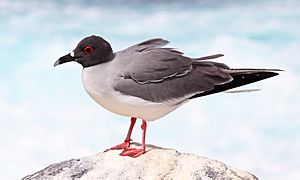
Gulls live all over the world. You can find them on every continent, even near Antarctica. They also live in the far northern Arctic regions. They are not as common on tropical islands. However, a few species do live on islands like the Galapagos and New Caledonia.
Many gulls build their nests in large groups called colonies along the coast. They prefer to nest on islands. One type, the Grey Gull, even nests in dry deserts far from water. Gulls can live and find food in many different places. These include marine (ocean), freshwater (lakes and rivers), or land habitats.
Most gull species migrate. This means they move to warmer places during the winter. How far they travel depends on the species. Some gulls, like the Franklin's gull, fly very long distances. They travel from Canada to South America for the winter. Other gulls move shorter distances. They might just spread out along the coasts near where they nested.
Gull Behavior and Diet
What Gulls Eat
Gulls are very flexible eaters. They will eat almost anything they can find. Their diet includes fish, sea creatures, and freshwater insects. They also eat land insects like worms, small animals like rodents, eggs, and dead animals. They can eat parts of animals that are thrown away, reptiles, amphibians, and even plants like seeds and fruit. Gulls are also known to eat human trash and sometimes even other birds.
No gull species eats only one type of food. They also don't use just one way to find food. What they eat depends on where they are and what is available. For example, they eat more land animals like worms and plants during the breeding season. They eat more sea animals when they spend more time near large bodies of water.
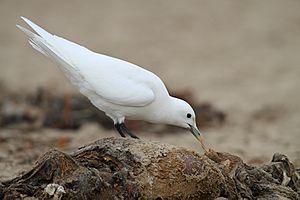
Gulls are very clever at getting food. They can catch food in the air, on the water, or on land. Some gulls can catch insects while flying. Larger gulls do this less often. Gulls flying in the air will also snatch items from the water or the ground. Over water, they can dive into the water to catch prey. Smaller gulls are better at hovering and dipping to catch fish from the air.
Gulls also dip for food when they are sitting on the water. They might swim in tight circles or paddle their feet to bring small sea creatures to the surface. They also find food by searching on the ground, especially on beaches among sand, mud, or rocks. Larger gulls tend to do more of this type of feeding. In shallow water, gulls might also paddle their feet.
A unique way gulls get food is by dropping hard shells, like clams and mussels, onto hard surfaces. They might fly a long way to find a good spot to drop the shells. Older gulls are better at this than younger ones, which means they learn how to do it over time. Gulls learn many different ways to find food as they get older. This learning period might be why gulls take longer to grow up than some other birds.
Gulls cannot dive very deep underwater to find food. To get food from deeper areas, many gulls work with other animals. For example, some gulls feed around mud plumes created by Grey Whales when they are eating. They also feed near Orcas (the largest dolphin species) when the orcas drive prey to the surface.
Gull Reproduction and Life Cycle
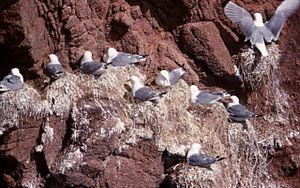
Gulls usually have only one mate for their whole life. They also nest in large groups called colonies. If a pair of gulls separates, it can cause problems for them for several years. Gulls also tend to return to the same nesting colony year after year. They often even use the same spot within that colony.
Gull colonies can be small, with just a few pairs, or very large, with over a hundred thousand pairs. Sometimes, only gulls live in a colony. Other times, they share it with different seabird species. A few gull species nest alone. Single pairs of Band-tailed Gulls might even nest in colonies of other birds. Within colonies, gull pairs protect their own space around their nest. This space can be as large as 5 meters (16 feet) around the nest for a Herring gull. For kittiwakes, it might be just a tiny spot on a cliff ledge.
Most gulls lay eggs once a year. Their breeding season lasts for three to five months. Gulls start gathering near the colony a few weeks before they begin nesting. Pairs that have mated before will strengthen their bond. Gulls that don't have a mate will start looking for one. Then, birds move into their nesting areas. New males will find new areas and try to attract females. Gulls protect their areas from other gulls by making calls and attacking from the air.
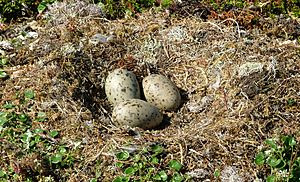
Building a nest is also part of how gulls bond as a pair. Gull nests are usually made of plant material, with a cup in the middle for the eggs. Nests are usually built on the ground. However, some species build nests on cliffs, like the kittiwakes. In some cases, like Bonaparte's gulls, they even build nests in trees. Gulls that nest in marshes must build a platform to keep their nest dry, especially in areas with tides. Both male and female gulls gather materials and build the nest.
Gulls typically lay three eggs. Some smaller species lay two eggs, and the Swallow-tailed Gull lays only one. Within a colony, gulls tend to lay their eggs around the same time. The eggs are usually dark tan to brown or dark olive with dark spots and markings. This helps them blend in with their surroundings. Both parents take turns sitting on the eggs to keep them warm. Each parent might sit for one to four hours during the day. One parent will sit on the eggs all night.
The eggs hatch after 22 to 26 days. Incubation starts after the first egg is laid, but it's not continuous until the second egg is laid. This means the first two chicks hatch close together, and the third chick hatches a bit later. Young chicks are kept warm by their parents for about one or two weeks. At least one parent usually stays with them until they can fly (fledge) to protect them. Both parents feed the chicks. Early on, the male often does most of the feeding, while the female does most of the brooding and guarding.
Related pages
Images for kids
-
Flying subadult silver gulls at Kiama beach, Australia, during Christmas 2013
-
Black-legged kittiwakes nest colonially, but have tiny, closely packed territories
-
Western gull at Point Lobos State Natural Reserve, CA, USA
-
American herring gull eating a starfish
-
Gull attacking a coot – this gull is probably going after the bread or other food item in the bill of this American coot, though great black-backed gulls are known to kill and eat coots
-
Juvenile ring-billed gull at Sandy Hook, New Jersey
-
European herring gull stealing food from a man's hand
See also
 In Spanish: Gaviotas para niños
In Spanish: Gaviotas para niños









